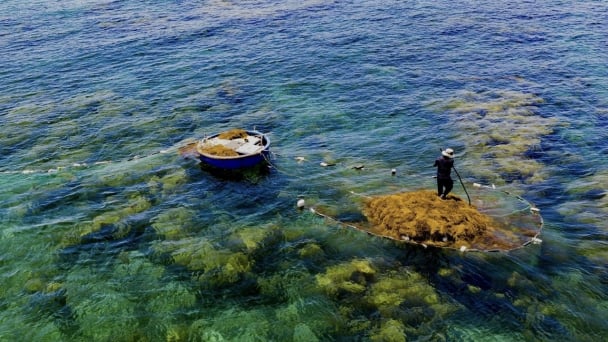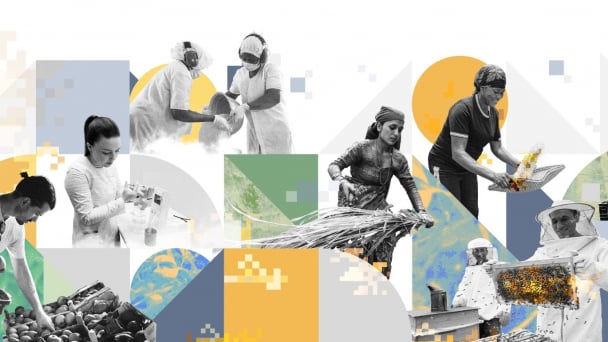June 21, 2025 | 02:40 GMT +7
June 21, 2025 | 02:40 GMT +7
Hotline: 0913.378.918
June 21, 2025 | 02:40 GMT +7
Hotline: 0913.378.918
Dak Lak has the second-largest wet rice area in the Central - Central Highlands region. For a long time, people have been farming in traditional ways, focusing only on productivity. Last winter-spring season, Dak Lak piloted a carbon emission-reducing rice production model, initially bringing efficiency.
In the winter-spring crop of 2023–2024, Dak Lak implemented a pilot model of carbon emission-reducing rice production on an area of more than 4 hectares in Binh Hoa commune (Krong Ana district). This model is deployed according to the green rice farming process, reducing emissions and increasing productivity.

Dak Lak piloted a carbon emission-reducing rice production model on an area of more than 4 hectares in Binh Hoa commune, Krong Ana district. Photo: Quang Yen.
This is a solution that combines the process of alternating wet - dry rice farming of the International Rice Research Institute (IRRI), combines the use of Nanocomposite products from BSB Nanotech Joint Stock Company, and applies the emission reduction reporting and verifying process of Net Zero Carbon Joint Stock Company.
As one of the first people to participate in the model, Mr. Le Nhu Hung (living in Binh Hoa commune, Krong Ana district) said that rice farming applying solutions to reduce carbon emissions helps reduce fertilizer and pesticide costs by 10-15%, but productivity is still guaranteed at a high level.
According to Mr. Hung, the benefit of this farming is that it contributes to protecting the environment and increasing income from carbon certification. In particular, in the context of increasing drought conditions, it is very important to follow a farming model that reduces the amount of irrigation water by 40–50%, thereby helping to protect water sources and avoid the risk of lacking production water in the dry season.
“The carbon emission-reducing production method and process are not difficult, and farmers can completely comply. However, farmers need additional support from organizations and businesses in terms of techniques, agricultural materials, and product output.
In addition, the State needs to have mechanisms and solutions to strongly develop carbon emission-reducing agricultural production so that many farmers can participate and join hands in achieving the goal of reducing greenhouse gas emissions," Mr. Hung said.
According to Mr. Tran Minh Tien, General Director of Net Zero Carbon Joint Stock Company, up to now, it can be confirmed that the area participating in the model has very high output (more than 11.7 tons/ha, compared to the district's average of about 8.7 tons/ha).

Not only saving irrigation water, fertilizer, and pesticides, rice in the model grows healthily and is free from pests and diseases; the productivity reaches more than 11 tons/ha, 3 tons/ha higher than the average in Krong Ana district. Photo: Quang Yen.
This shows that emission-reducing rice farming does not affect productivity at all but increases it by up to 30% and reduces input costs by 10%. In particular, there is no disease spot on the rice plant, proving that the rice plant is very disease-free and healthy.
"According to preliminary calculations, in this crop, the model is expected to reduce carbon emissions by about 3.5 tons/ha while also reducing the amount of water used by 50%. This is extremely good data, especially in the current water scarcity situation.
We are waiting for the official report of Spiro Carbon Company (USA) to provide emissions reduction data from this model. After that, the company will announce the amount of carbon emissions reduced and buy them back from farmers at a unit price of USD 20/ ton of carbon. At the same time, give carbon certification for Vietnam's first rice products to Dak Lak farmers. As of now, it can be confirmed that the model has been successful beyond expectations," Mr. Tien said.
Dak Lak currently has a wet rice area of over 40,000 hectares, which has great potential to exploit new values in the agricultural sector. However, Dak Lak is still limited in forming large-scale, concentrated production areas and producing according to standards.
On the other hand, market requirements are increasingly strict, no longer simply creating delicious, quality products but also taking on the responsibility to protect the environment, human health, and crop "health." This forces actors involved in the agricultural sector to change their thinking, farming processes, etc. to match global consumption trends.

The carbon emission-reducing rice production model has proven effective, laying the foundation for spreading to other localities in Dak Lak. Photo: Quang Yen.
According to Mr. Tran Minh Tien, the most difficult thing in emission-reducing production is getting farmers to accept the change, which is recalculating nutrition for rice plants because people in this area use too much fertilizer on rice plants. In addition, people also need to change the production process to alternating wet - dry farming with the correct techniques, because this process has been done before but not done correctly. At the same time, implementing this process requires rice-growing areas to have a guaranteed irrigation system, which is a big challenge for localities in Dak Lak.
"Dak Lak has a large rice area, and the local government also creates favorable conditions for people and businesses. After receiving results from Spiro Carbon Company, the business will have a review meeting with the Dak Lak Department of Agriculture and Rural Development to propose continued implementation and expansion of the emission-reducing rice production model," said Mr. Tien.
Currently, low-emission agriculture is one of the top priorities of the Ministry of Agriculture and Rural Development, contributing to implementing Vietnam's commitments at COP26. Dak Lak is also making efforts to promote green, sustainable, and low-emission agriculture to turn invisible "cash flows" into tangible ones through the new value of agricultural products.

Mr. Nguyen Hac Hien, Director of the Dak Lak Sub-Department of Crop Production and Plant Protection (right), said that the locality is developing a plan to expand the carbon emission-reducing rice production area. Photo: Quang Yen.
According to the assessment of the Dak Lak Department of Agriculture and Rural Development, emission-reducing agricultural production is a strategic program of the Government. Up to this point, Dak Lak has implemented the model not only on rice but also on many other crops.
Mr. Nguyen Hac Hien, Director of the Dak Lak Sub-Department of Crop Production and Plant Protection, said that the carbon emision-reducing rice production model has initially brought efficiency. Farmers participating in the model have basically grasped the technical procedure throughout the production process until harvest.
People participating in the model are not under much pressure when farming according to the new process. The process is carried out in an alternating wet-dry form, reducing input materials by 10–15% and especially irrigation water by up to 50%.
"The model not only can sell carbon credits but also has higher productivity, in which ensuring the environment is the most important. In the coming time, the locality will develop a plan to implement the model mainly in the winter-spring crop and secondarily in the summer-autumn crop because they are related to water sources. The Department will have a meeting to summarize the model and replicate it in the coming time," Mr. Hien informed.
Translated by Thu Huyen
![Turning wind and rain into action: [10] Advancing accessible climate services for farmers](https://t.ex-cdn.com/nongnghiepmoitruong.vn/608w/files/linhnhp/2025/06/20/1911-z6704423696987_15fd32ffc26d590d204d520c9dac6786-nongnghiep-161854.jpg)
(VAN) Not only does it help farmers 'avoid droughts and rains,' the development of agricultural climate services also enhances their ability to proactively adapt to a rapidly changing climate.

(VAN) With international assistance, the harvesting of sargassum seaweed in Quang Ngai has become increasingly regulated, thereby safeguarding marine life and ensuring the stability of coastal communities' livelihoods.

(VAN) On June 19, the United Kingdom officially became a Development Partner of the Mekong River Commission.

(VAN) Biodiversity is being threatened by traditional remedies made from wildlife. Traditional medicine and humans must change to live in harmony with nature.

(VAN) Agrifood investment and finance solutions for people and the planet.

(VAN) Microplastic contamination has become pervasive in seafood, posing unprecedented challenges for food safety and marine ecosystems.

(VAN) Proactively using vaccines, combined with transport control and enhanced surveillance, is the only viable path toward biosecure and sustainable livestock production in Vietnam.